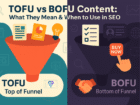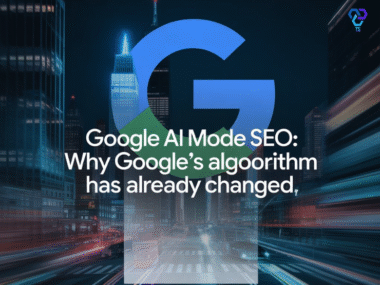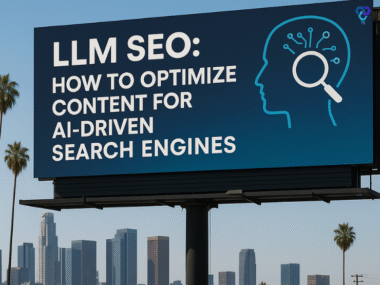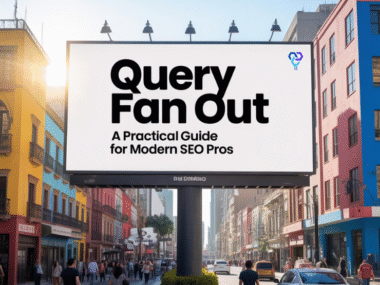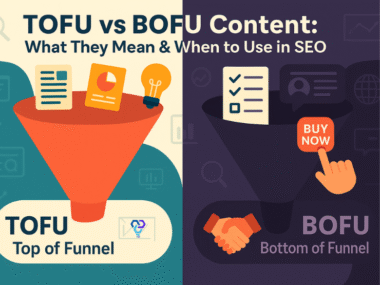Imagine searching for “best project management software” and seeing Google’s AI Overview answer your question before you even click a link. That’s happening in 47% of all searches right now, and most websites are completely unprepared.
Here’s the truth: To rank in AI Overviews, you need to master AIO optimization – combining traditional SEO with extraction-friendly content that AI systems can easily understand and cite.
The challenge? AI Overview SEO isn’t just about ranking anymore. It’s about making your content so clear and valuable that Google’s ai-generated responses choose your website as the trusted source. When you optimize for ai overviews, you’re not just hoping for visibility – you’re engineering it.
Your content must align perfectly with how AI systems scan, extract, and present information. This means combining traditional SEO strategies with new approaches like structured data markup, answer-first formatting, and entity-based optimization.
Think about it: If your competitors are still writing for humans only, while you’re writing for both humans and AI systems, who wins?
This guide gives you the exact content strategy and checklist to rank in ai overview results consistently, turning Google’s AI transformation into your biggest competitive advantage.
What Google AI Overviews & AI Mode Actually Are
AI Overview is Google’s quick, AI-written summary box that pulls facts from the web and shows source links.
AI Mode is a deeper, chat-style page where you keep asking follow-ups and get guided steps.
AI Overview (AIO)
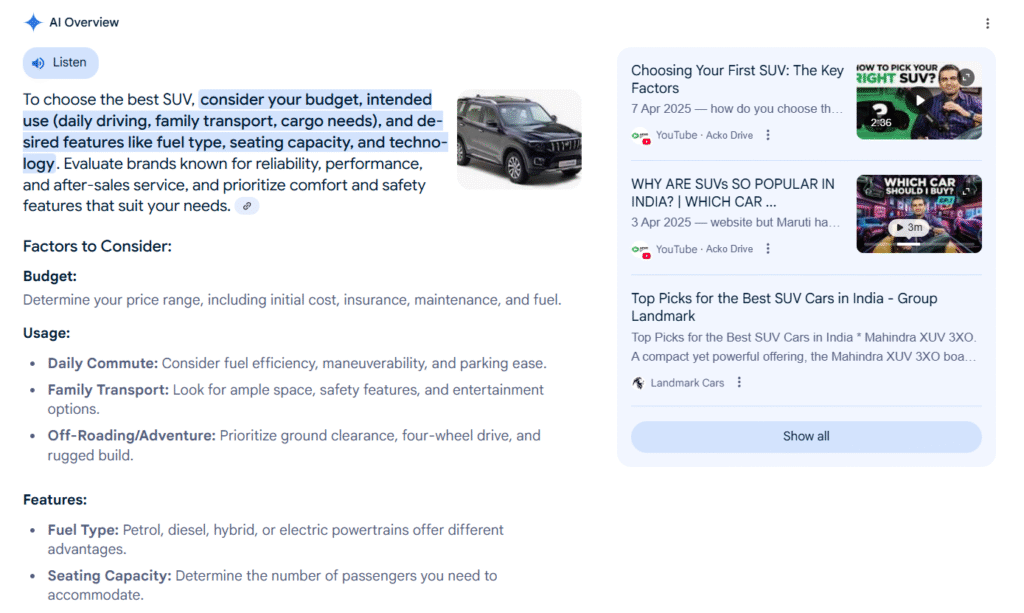
AI Overview is the fast answer box you see on Google. It creates ai summaries from trusted pages, then shows ai answers with source links.
In many tests, google ai overviews appear in roughly 13-47% of searches, mostly for informational topics. When you expand the box, you often see several links (around 7 on average) so users can check sources.
For AI Overview SEO, your goal is ai overview optimization, make pages easy to quote and to trust. Think short, clear sections, clean lists, and correct structured data markup.
If you optimize for ai overviews, you can rank in AI Overviews even if you’re not #1 in traditional search engines.
AI Mode
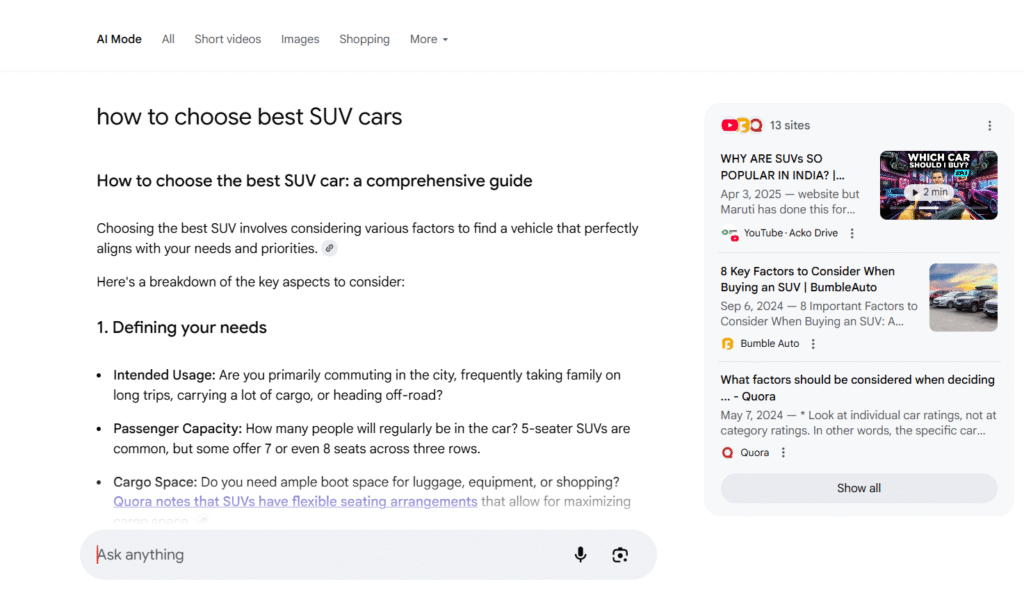
AI Mode opens a full screen with ai chatbots-like behavior. You ask a question, then refine it. Google gives step-by-step ai answers, tools, and follow-ups. Think of this as the “long conversation” layer in the ai-driven search landscape.
It’s great for comparisons, planning, and multi-step tasks. For AI SEO, treat AI Mode like a research assistant: structure pages so the model can pull steps, pros/cons, criteria, and templates.
Use tight headings, clear definitions, and tables. This helps the system extract parts of your content during ai-driven search results and keep citing you.
AI Overview = the quick summary at the top of a chapter.
AI Mode = the full study session where you ask questions and take notes.
Comparison: AI Overview vs AI Mode vs Featured Snippe

How Google AI Overview Picks Links (Mechanics & Eligibility)
Google’s AI Overview system works like a super-smart librarian that scans millions of pages, finds the best answers, and picks the most helpful sources to cite – but only if your page meets specific eligibility requirements.
Here’s how it actually works: When you search for something, Google’s AI doesn’t just look at whole web pages. Instead, it breaks down pages into small chunks (called “passages”) and picks the best pieces from different websites to create one complete answer.
What is their Selection Process? From Search to Citation
Google’s system follows a simple four-step process:
- Query Analysis – Google figures out exactly what you’re asking
- Fan-out Search – The AI looks for related questions and topics
- Candidate Passages – It finds the best text chunks from eligible pages
- Citation Selection – It picks which sources to link and display
This keyword matching process happens in milliseconds, but it relies on pages that follow specific rules to get cited in AIO.
What Makes Your Page Eligible?
The ai overview eligibility requirements are actually simpler than most people think. Your page needs to check these boxes:
- Fully indexable – Google can crawl and understand your page completely
- Snippet-friendly – Your content isn’t blocked by meta tags or robots.txt
- Clear, visible text – Real content that visitors (and AI) can easily read
- Structured properly – Good headings, paragraphs, and logical flow
- Fast loading – Pages that load quickly get priority consideration
- Mobile-friendly – Works perfectly on phones and tablets
Myth Buster: You don’t need special AI schema markup or secret text files. Google uses the same content that regular visitors see on your page.
Which key ranking signals Google AI Overview uses?
The signals google uses for ai overview selection focus on content quality and helpfulness:
- Authority Signals – Your website’s overall trustworthiness and expertise
- Content Freshness – Recently updated information gets priority for trending topics
- Answer Quality – Clear, direct responses to common questions
- Source Diversity – Google prefers citing multiple different websites
- User Engagement – Pages where people stay longer and find value
The ai overview ranking factors that matter most are the same ones that help with regular search rankings – just applied at the passage level instead of the whole page.
The bottom line? Focus on creating helpful, well-structured content that directly answers questions, and Google’s AI will naturally consider your pages for citations. No special tricks or hidden techniques required – just good, useful content that follows basic web standards.
Design Pages for Extraction (Answer-First Content Architecture)
To get cited in AI Overviews, format your content using the Answer-First method: Start each section with a direct answer (40-80 words), then add details, evidence, and links.
Think of it like answering a friend’s question. Give them the answer first, then explain why it works.
The Simple Template That Works
Every section on your page should follow this content format for ai overview success:
Step 1: Lead Answer (40-80 words)
Answer the question directly in the first paragraph. No fluff or setup – just the answer.
Step 2: Supporting Details (150-300 words)
Explain how it works, why it matters, and give helpful context.
Step 3: Proof
Add one piece of evidence – a statistic, example, or expert quote.
Step 4: Helpful Links
Include 2-3 links to related pages on your site.
Content Formats That Get Cited Most
Lists and Steps
- Number your steps clearly (Step 1, Step 2…)
- Keep each step short and actionable
- Use bullet points for quick tips
Comparison Tables
- Show different options side by side
- Include pros and cons for each choice
- Add cost or difficulty ratings
Quick Definitions
- Define important terms in 1-2 sentences
- Use simple language everyone understands
- Put definitions in boxes or bold text
FAQ Sections
- Answer 5-8 common questions
- Keep answers under 100 words each
- Use the question as your heading
Writing Rules for AI Success
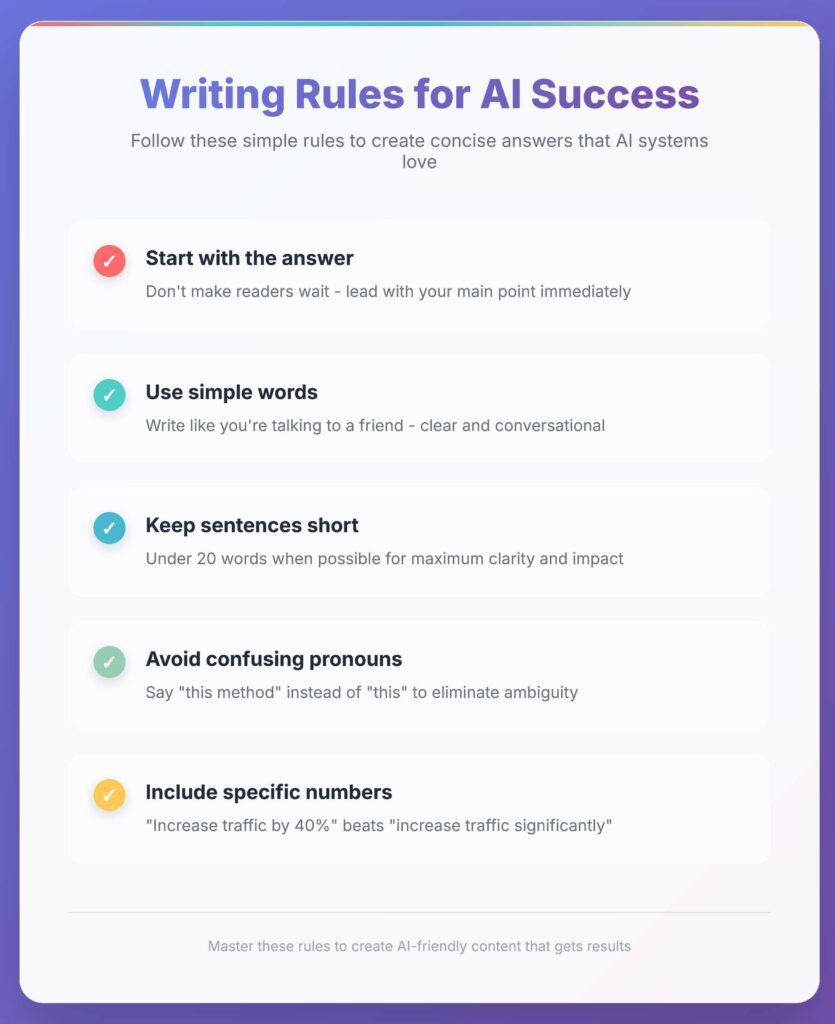
When you follow this best content formats that get cited by ai overview approach, your pages become magnets for AI citations. The secret is keeping things simple, direct, and helpful – exactly what both readers and AI systems want to see.
Align to Intent with Entities & Semantics
Entity-based SEO means connecting your content to the people, places, things, and concepts that Google’s AI understands. When you align entities properly, your content becomes much more likely to get cited in AI Overviews.
Think of entities like building blocks. Google’s AI knows that “iPhone” connects to “Apple,” “smartphone,” and “mobile phone.” When your content clearly shows these connections, AI systems understand your topic better.
What Are Entities and Why They Matter
Entity SEO for ai overviews works because Google’s AI thinks in relationships, not just keywords. An entity is any person, place, thing, or concept that has a clear identity.
For example, if you write about “content marketing,” the AI expects to see related entities like:
- People: Neil Patel, Ann Handley, content creators
- Companies: HubSpot, Mailchimp, social media platforms
- Concepts: lead generation, brand awareness, ROI
- Tools: CMS platforms, analytics, email software
When you include these connected entities, you’re optimizing your content for natural language the way people actually think and search.
How to Map Your Entity Network
Start with your main topic and build an “entity spiderweb” around it. Here’s how it works:
Step 1: List Your Core Entities (10 items)
Write down the main people, companies, tools, and concepts in your topic.
Step 2: Find the Relationships (10 connections)
Show how these entities connect to each other and your main topic.
Entity Spiderweb Example: “Email Marketing”
Core Entities:
- Mailchimp (email platform)
- Open rates (key metric)
- Subscribers (target audience)
- Templates (design tools)
- Automation (advanced feature)
- GDPR (privacy regulation)
- CRM integration (technical connection)
- A/B testing (optimization method)
- Deliverability (technical challenge)
- ROI tracking (business outcome)
Key Relationships:
- Mailchimp offers email templates
- Open rates measure subscriber engagement
- Automation improves ROI tracking
- GDPR affects subscriber management
- A/B testing optimizes open rates
- CRM integration connects subscriber data
- Templates increase email deliverability
- Subscribers generate business ROI
- Automation saves marketing time
- Deliverability impacts open rates
Writing Entity-Rich Content
When you practice entity alignment, follow these simple rules:
Define Key Terms Clearly
The first time you mention an important entity, explain it in one simple sentence.
Example: “Lead magnets are free valuable content (like eBooks or checklists) that businesses offer in exchange for email addresses.”
Use Natural Synonyms
Don’t just repeat the same word. Use different ways to say the same thing, just like people do in real conversations.
Instead of saying “email marketing” five times, mix in:
- Email campaigns
- Newsletter marketing
- Email automation
- Direct email outreach
Cover Adjacent Questions
AI systems often look for answers to related questions people might ask. If your main topic is “email open rates,” also answer:
- What’s a good open rate?
- How do you improve open rates?
- Why are my open rates low?
- What affects email deliverability?
The Context and Relevance of Your Content
Generative engine optimization requires showing clear context for every entity you mention. Don’t assume the AI (or readers) know what you’re talking about.
Good Entity Context:
“HubSpot, a leading CRM and marketing automation platform, reports that personalized emails generate 6x higher open rates than generic broadcasts.”
Poor Entity Context:
“HubSpot reports 6x higher open rates with personalization.”
The first example clearly establishes what HubSpot is, why their data matters, and how it connects to the main topic.
Quick Entity Glossary
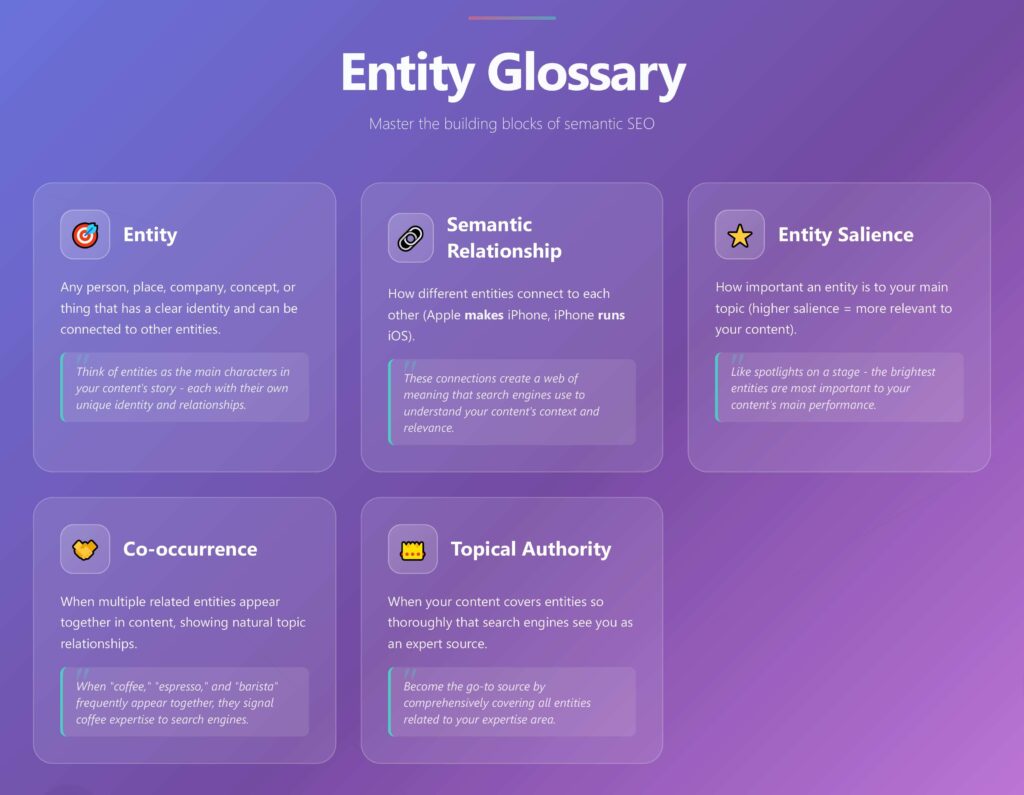
Building Entity-Based SEO That Works
Follow this simple process for every piece of content:
1. Research Your Entity Network
- List 15-20 entities related to your main topic
- Find the most important relationships between them
- Check what entities your competitors mention
2. Write Definitional Sentences
- Define each major entity the first time you use it
- Keep definitions under 25 words
- Use language a 12-year-old would understand
3. Show Clear Relationships
- Connect entities with action words (creates, improves, affects, requires)
- Explain why relationships matter to your readers
- Use specific examples that prove connections
4. Cover the Full Topic Web
- Answer the main question completely
- Address 3-5 related questions people ask
- Include both basic and advanced concepts
When you master entity alignment, your content becomes a comprehensive resource that AI systems trust and cite consistently. The key is thinking like your readers – what people, tools, and concepts do they need to understand to fully grasp your topic?
Entity-based SEO isn’t about stuffing your content with random related words. It’s about creating helpful, complete content that naturally covers all the important pieces of your topic puzzle.
Prove Experience & Authority (E-E-A-T, Links, Evidence)
Google’s AI systems trust content that shows real experience and expertise. To get cited in AI Overviews, you need first-hand evidence, clear author credentials, and links to trusted sources that prove you know what you’re talking about.
Think of it like this: Would you trust medical advice from someone who never studied medicine? Google’s AI thinks the same way about your content.
What Google Looks for in Trustworthy Content
- Experience means you’ve actually done what you’re writing about.
- Expertise means you have the skills and knowledge.
- Authoritativeness means others recognize you as credible.
- Trustworthiness means your information is accurate and honest.
Here’s what convinces Google’s AI that you’re reliable:
Real Evidence You Created
- Screenshots from your own tests and experiments
- Original photos you took yourself
- Data from your actual projects and results
- Case studies from your real clients or customers
Clear Author Information
- Author bio with relevant experience and credentials
- Professional headshot and contact information
- Links to your other published work and social profiles
- Clear editorial policy showing your standards
Quality Source Citations
- Links to original research studies, not summaries
- Government websites and official organization data
- Recent statistics from recognized industry authorities
- Brand mentions from credible companies and experts
How to Show First-Hand Experience
Take Your Own Screenshots
Don’t use stock images or borrowed screenshots. Show your actual tools, dashboards, and results. Google’s AI can often detect when images are original versus copied.
Share Specific Numbers
Instead of saying “significantly improved,” say “increased open rates from 18% to 24% over 6 weeks.” Specific data proves you actually did the work.
Include Original Photos
If you’re writing about a location, event, or physical product, include photos you took yourself. This shows you were actually there or used the product.
Reference Your Real Projects
Don’t make up examples. Use sanitized versions of actual work you’ve done, with permission from clients when needed.
Building Author Authority
Professional Bio Section
- Every article should include a clear author bio that shows:
- Relevant experience and years in the field
- Professional certifications or educational background
- Notable achievements or recognition in your industry
- Links to your LinkedIn, company website, or portfolio
Editorial Standards
- Create and link to an editorial policy page that explains:
- How you research and verify information
- Your process for updating content when facts change
- How you handle conflicts of interest
- Your commitment to accuracy and transparency
Strategic Brand Mentions for Authority
Cite Recognized Industry Leaders
- When you mention trusted brands and companies, you borrow some of their authority. Reference:
- Industry reports from companies like HubSpot, Salesforce, or Google
- Research from well-known universities and institutions
- Quotes from recognized experts and thought leaders
- Case studies from successful, named companies
Link to Primary Sources
Always link to the original source of information, not articles that summarize it. If you mention a statistic from a research study, link to the actual study, not a blog post about the study.
Trust Signals That Work
Recent Update Dates
Show when you last reviewed and updated your content. Fresh information signals that you’re actively maintaining accuracy.
Contact Information
Make it easy for people to reach you with questions or corrections. This transparency builds trust with both readers and AI systems.
Transparent Disclaimers
If you have any business relationships or potential conflicts of interest, mention them clearly. This honesty actually increases trust rather than decreasing it.
Social Proof
Include testimonials, case study results, and social media mentions when relevant. These show that real people have benefited from your expertise.
Quick Authority Checklist
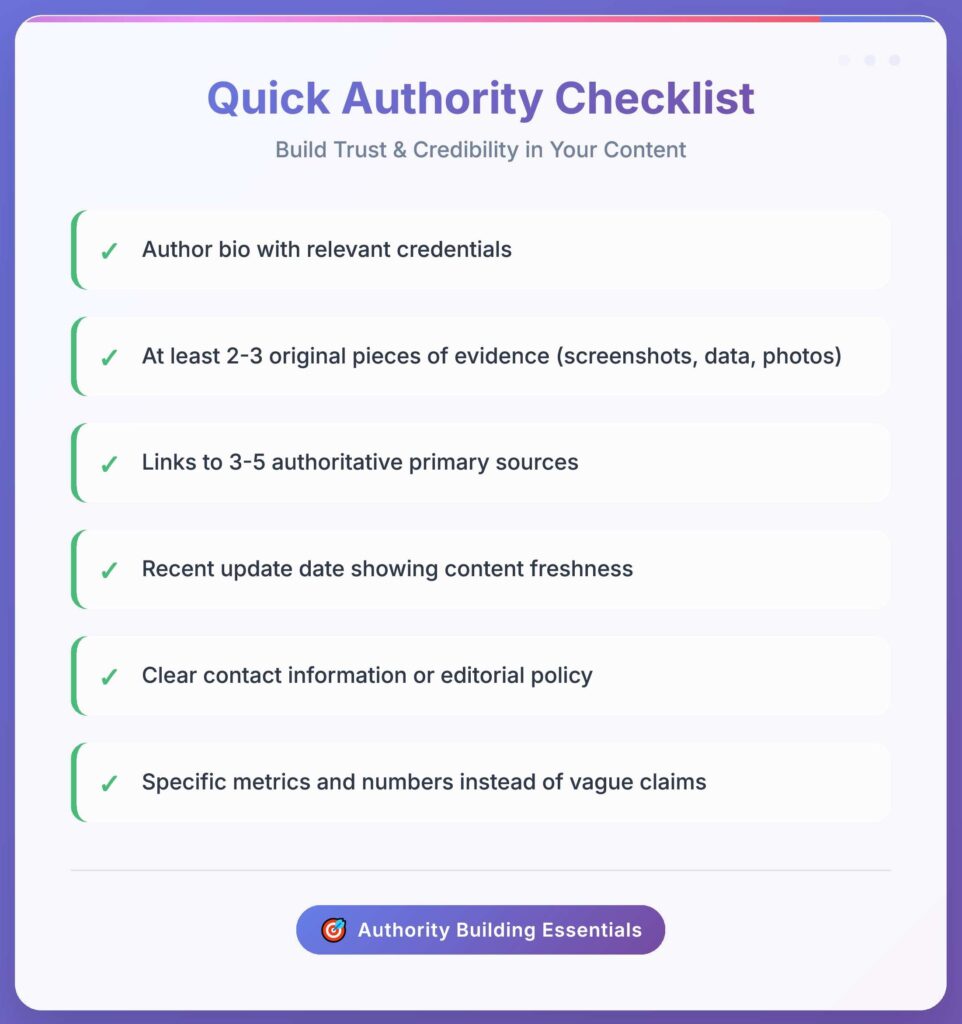
When you consistently prove your experience and authority, Google’s AI starts treating you as a trusted source. This means more citations, better rankings, and readers who actually trust your advice enough to take action.
Remember: Brand mentions and expert citations help, but nothing beats showing your own real experience and results. That’s what separates content that gets cited from content that gets ignored.
Build Topic Authority with Internal Links
Internal linking for AI overview success means creating a hub-and-spoke system where your main topic page connects to detailed subtopic pages, and everything links back within two clicks. This shows Google’s AI that you’re the complete authority on your subject.
Think of your website like a library. Your main topic page is the information desk that points visitors to the right sections. Your subtopic pages are the specialized sections with detailed information.
The Hub-and-Spoke Structure That Works
Your Hub (Pillar Page)
This is your main topic page that covers the subject broadly. For “AI Overview SEO,” your hub would explain what AI Overviews are, why they matter, and give an overview of optimization strategies.
Your Spokes (Supporting Pages)
These are detailed pages that dive deep into specific aspects:
- How-to guides: “How to Optimize Headings for AI Overviews”
- Comparison pages: “AI Overviews vs Featured Snippets: What’s the Difference”
- Glossary pages: “AI Overview SEO Terms You Need to Know”
- Case studies: “5 Websites That Dominate AI Overview Results”
Your Utilities (Helpful Tools)
These are practical resources that add extra value:
- Checklists: “AI Overview Optimization Checklist”
- Calculators: “Content Readability Score Calculator”
- Templates: “Answer-First Content Template”
- Tools: “Internal Link Opportunity Finder”
The Two-Hop Rule for Topical Depth
Every important page on your site should be reachable within two clicks from your hub page. This internal linking strategy for ai overview success works because:
One Click from Hub: Takes you to main subtopic pages
Two Clicks from Hub: Takes you to specific, detailed information
Example Structure:
Hub: “AI Overview SEO Guide” →
Spoke: “Content Optimization for AI Overviews” → Detail: “How to Write Answer-First Paragraphs”
This structure helps Google’s AI understand that you have complete coverage of your topic, not just surface-level information.
How to Build Topical Maps That Align With AI Overview
Step 1: Map Your Main Topic
Start with your primary keyword and list 15-20 related subtopics that people search for.
Step 2: Group by Intent
Organize subtopics into logical groups:
- Learn: What is AI Overview SEO?
- How-to: How to optimize for AI Overviews
- Compare: AI Overviews vs other search features
- Tools: Resources and templates
Step 3: Create Your Coverage Heatmap
Build a simple table showing which topics you cover and how thoroughly:
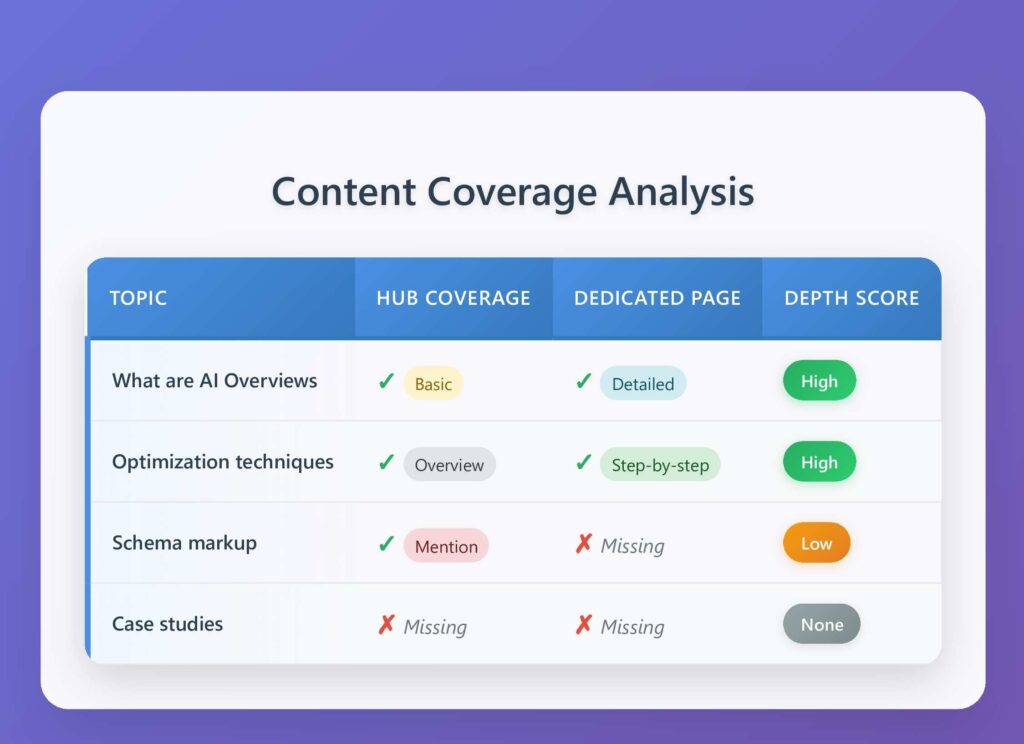
Step 4: Fill the Gaps
Create new content for any topic with “Low” or “None” coverage.
Writing Anchor Text That AI Systems Love
Use Descriptive Anchors
Instead of “click here” or “read more,” use anchor text that mirrors the exact questions people ask:
Good Examples:
- “Learn how to optimize headings for AI Overview visibility”
- “See our complete guide to structured data for AI Overviews”
- “Check out these proven AI Overview content templates”
Bad Examples:
- “Click here for more information”
- “Read this helpful guide”
- “Learn more about this topic”
Match Sub-Questions
Your anchor text should match the specific questions your linked page answers. If your page answers “How long should meta descriptions be for AI Overviews?”, use that exact phrase as your anchor text.
Strategic Link Placement Under Each Section
Add a “Related Reading” section under each major H2 heading with 2-3 relevant internal links:
Related Reading:
- [Complete Guide to AI Overview Eligibility Requirements]
- [How to Structure Content for AI Citations]
- [AI Overview Case Studies: What Works in 2025]
This helps both readers and AI systems discover your related content naturally.
Coverage Heatmap Process
Week 1: Audit Current Content
List all your existing pages and rate their topic coverage (High/Medium/Low/None).
Week 2: Identify Gaps
Find topics where you have Low or None coverage, especially high-search-volume keywords.
Week 3: Plan New Content
Create content briefs for your biggest gaps, prioritizing topics that support your main hub page.
Week 4: Link Optimization
Update existing pages with better internal links using descriptive anchor text.
The Internal Linking for AI Overview Success Formula
From Hub to Spokes (3-5 links per section)
Your main topic page should link to relevant subtopic pages in each major section.
From Spokes Back to Hub (1-2 links)
Every subtopic page should link back to your main hub page for “complete guide” or “overview” context.
Between Spokes (2-3 cross-links)
Related subtopic pages should link to each other when it adds value for readers.
To Utilities (1-2 links per page)
Link to your helpful tools and resources when they support the content.
Quick Internal Link Checklist
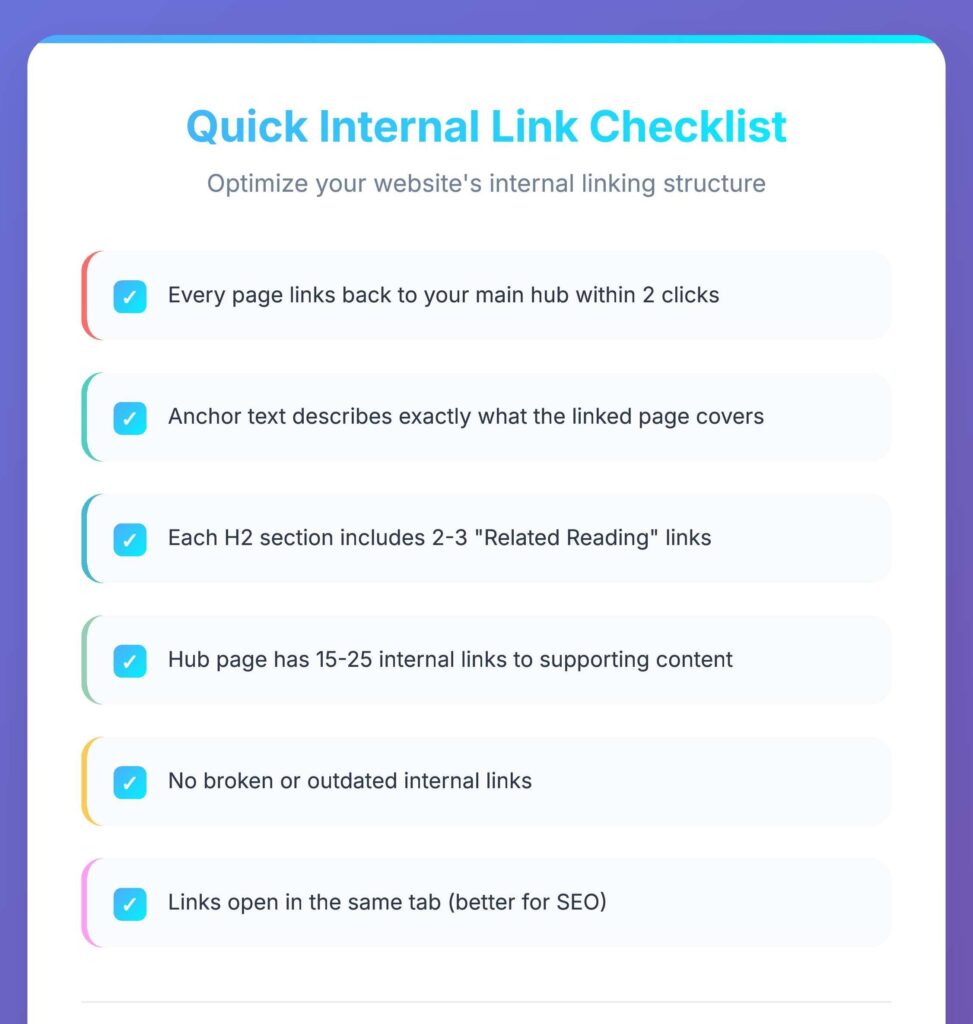
Remember: Internal linking for ai overview success isn’t about having the most links. It’s about creating logical, helpful connections that make your content ecosystem easy to navigate for both humans and AI systems.
Technical Foundations & Page Experience
Technical SEO forms the foundation for AI Overview success. Your page must be crawlable, indexable, fast-loading, and mobile-friendly before Google’s AI can even consider citing your content.
Think of technical SEO like building a house. You need a solid foundation before you can add the beautiful rooms. Without proper technical setup, even the best content won’t get noticed by AI systems.
Core Technical Requirements
Crawlable and Indexable
- Google’s bots must be able to find and read your page completely. This means:
- No robots.txt blocking important pages
- Clean URL structure without unnecessary parameters
- Working internal links that lead to your content
- XML sitemap that includes all important pages
Snippet-Eligible Content
- Your page must be allowed to appear in search results and AI Overviews:
- No
noindextags on important content pages - No
nosnippetmeta tags that block AI extraction - Paywall content properly configured to show previews
- Key information visible to both users and search bots
Page Speed and Core Web Vitals
Fast-loading pages have 1.8x higher inclusion rates in AI Overviews. Google’s AI systems process faster pages more efficiently, affecting both traditional search engines rankings and AI citations.
Good Core Web Vitals Scores
- Largest Contentful Paint (LCP): Under 2.5 seconds
- First Input Delay (FID): Under 100 milliseconds
- Cumulative Layout Shift (CLS): Under 0.1
These metrics directly impact how AI systems evaluate and process your content quality.
Mobile-First Optimization
Perfect Mobile Experience
Since mobile AI Overviews appear 3x more often for commercial queries and occupy up to 76% of screen space:
- Responsive design that works on all screen sizes
- Touch-friendly buttons and navigation
- Text large enough to read without zooming
- Fast loading on mobile networks
Mobile-Specific AI Considerations
- Content that’s easy to scan on small screens
- Short paragraphs (2-3 sentences maximum)
- Clear headings that work as mobile anchor points
Structured Data That Matches Visible Text
Schema Markup Alignment
Your structured data must match exactly what users see on the page. Mismatched schema can disqualify you from AI Overviews entirely.
FAQ Schema Priority
FAQ schema increases AI citation chances by 4.1x, but only when:
- Questions match what people actually search for
- Answers are visible on the page in plain text
- Schema code reflects the exact visible content
Other Important Schema Types
- Article schema for blog posts and guides
- Organization schema for author/company credibility
- Breadcrumb schema for site structure clarity
Media Accessibility and AI-Friendly Formats
Alt Text for Images
- Every image needs descriptive alt text that:
- Explains what’s in the image clearly
- Includes relevant keywords naturally
- Helps AI systems understand visual content context
Video Transcripts and Captions
- Full text transcripts for all video content
- Accurate closed captions for accessibility
- Key points from videos repeated in text format
Keep Crucial Facts in Plain HTML
Don’t hide important information inside images or videos only. AI systems need text they can extract and quote.
Pre-Publish Technical Checklist

Remember: Technical SEO isn’t glamorous, but it’s absolutely essential for AI Overview success. You can have the world’s best content, but if Google’s AI can’t access, understand, and extract it properly, you’ll never get cited.
Compliance, Freshness & Safety
Google’s AI systems prioritize fresh, trustworthy content and actively avoid pages with thin content, misleading information, or reputation abuse. Maintaining content freshness for ai overview success means regular updates, clear timestamps, and avoiding red flag behaviors that get pages sidelined.
Think of content freshness like food safety – fresh content gets served to users, while stale or questionable content gets filtered out by Google’s quality systems.
What Content Abuse Looks Like
Scaled Content Abuse
This happens when websites create lots of low-quality pages quickly, often using AI or templates without human oversight:
- Hundreds of similar “city + service” pages with minimal unique content
- AI-generated articles published without fact-checking or editing
- Duplicate content across multiple domains you control
- Thin pages with under 300 words that don’t answer the main question
Reputation Abuse
- This involves trying to trick Google’s trust signals:
- Fake author profiles with made-up credentials
- Buying expired domains just for their authority, then changing topics completely
- Guest posting on unrelated sites only for backlinks
- Creating fake business listings or testimonials
Update Cadence by Content Type
Breaking News Topics: Daily
- Current events, trending topics, breaking industry news
- Stock prices, weather updates, sports scores
- Government policy changes, regulatory updates
Evergreen How-To Guides: Every 6 Months
- Step-by-step tutorials, best practices guides
- Tool reviews, software comparisons
- Educational content that doesn’t change quickly
Statistical/Research Content: Every 3 Months
- Industry reports, survey results, market analysis
- Performance benchmarks, pricing data
- Trend analysis and forecast articles
Product Reviews: Monthly
- Software reviews, app comparisons
- Product features and pricing updates
- Availability and specification changes
Freshness for AI Overview Best Practices
Update Statistics Regularly
Replace old data points with current ones, and always include the year: “Email marketing has a 4200% ROI according to 2024 research from DMA.”
Review Competitor Changes
Check top-ranking competitors quarterly to see if they’ve added new information or changed their approach to your topic.
Monitor Search Trends
Use Google Trends to identify when topics are heating up and need fresh content updates.
Track Your AI Citations
Monitor which of your pages get cited in AI Overviews, and prioritize updating those pages first since they’re already proven valuable.
Quality Maintenance Checklist
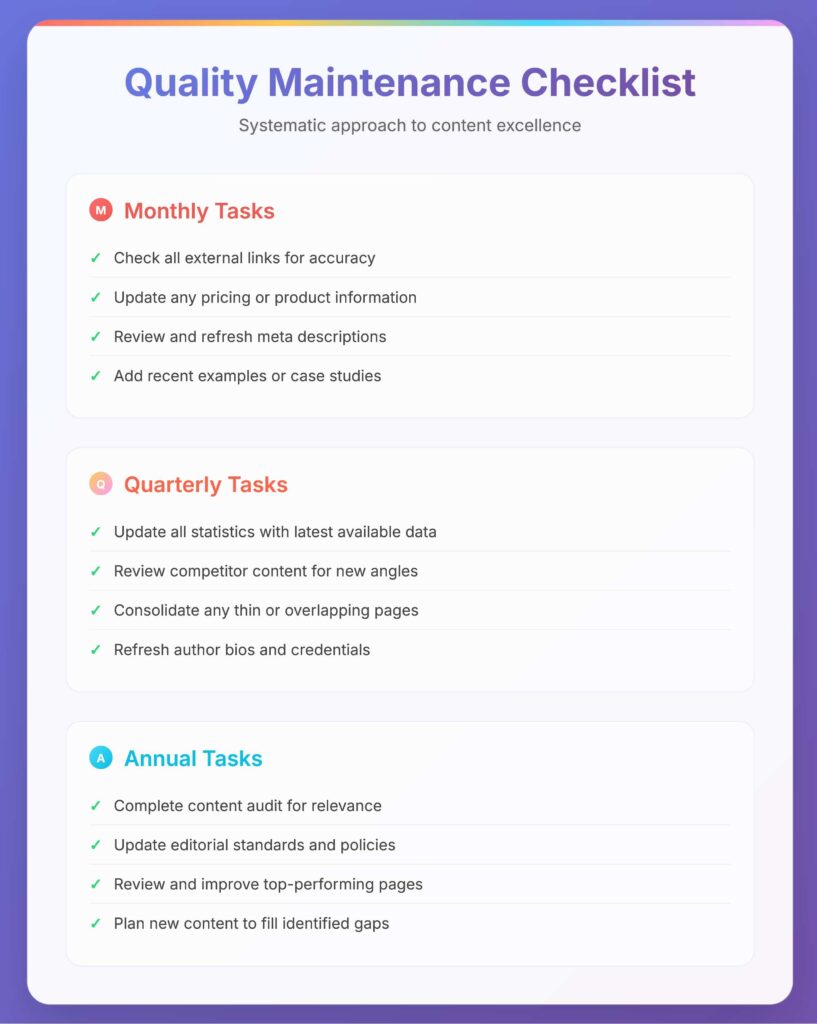
Timeline for Different Content Types
Time-Sensitive Content (News, Trends):
- Update within 24-48 hours of new developments
- Monitor breaking news in your industry daily
- Set up Google Alerts for key topics
Educational Content (How-tos, Guides):
- Review every 3-6 months for accuracy
- Update when tools or methods change
- Refresh examples and screenshots annually
Reference Content (Lists, Comparisons):
- Monthly updates for pricing and features
- Quarterly reviews for new additions/removals
- Annual comprehensive restructuring if needed
Remember: Freshness for ai overview success isn’t about changing everything constantly. It’s about maintaining accuracy, relevance, and trustworthiness through strategic updates and quality maintenance. Focus on keeping your most important pages current, and Google’s AI will reward you with more citations and better visibility.
Conclusion: The Playbook in One Page
Getting cited in AI Overviews isn’t luck – it’s a system. Master eligibility, structure, evidence, authority, and measurement to consistently win AI citations while competitors struggle.
AI Overview success comes from five essential elements working together:
- Technical Eligibility – Crawlable, indexable, fast-loading pages that AI systems can access
- Extraction-Friendly Structure – Answer-first content with clear headings and structured data
- Strong Evidence – First-hand experience, original research, and proper source citations
- Topic Authority – Comprehensive coverage through internal linking and semantic depth
- Ongoing Measurement – Regular monitoring, testing, and content updates
AI Overview optimization aligns with Google’s mission: making information accessible and useful. When you create genuinely helpful, well-structured, trustworthy content, both humans and AI systems naturally choose it.
The competitive advantage goes to websites mastering these fundamentals while competitors still write content the old way.
The future belongs to websites that master both human engagement and AI extraction. Your AI Overview domination starts now.

